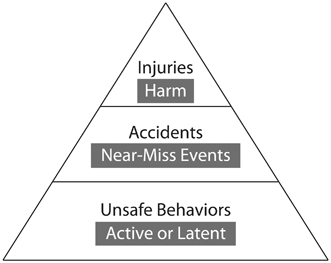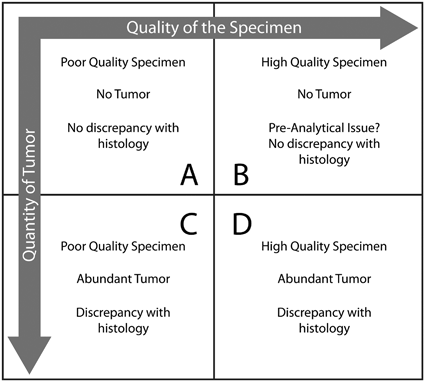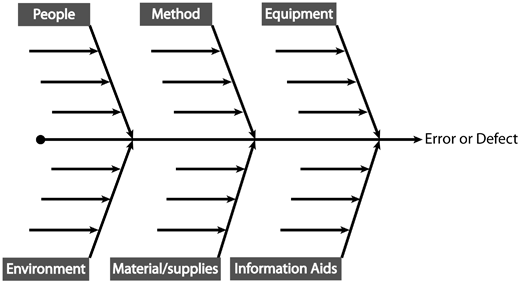Fig. 3.1
The Swiss Cheese Model of error causation. Each slice of cheese represents a step in the health care process. The “holes” represent errors in each individual step, either active or latent. Some of latent holes are relatively consistent. The active holes may open and close depending on worker behavior. a Most errors result in a near-miss event as the subsequent step recognizes the threat and disarms it. b Rarely, defects in all the steps line up and provide access to the patient for harm. (Adapted from Reason [14])
Heinrich investigated safety and accident causation in the industrial field and developed the Safety Pyramid, which is often referred to as Heinrich’s Safety Pyramid (Fig. 3.2) [16] . His original theory was that the base of the pyramid consisted of unsafe behavior by workers. This widespread unsafe work occasionally led to accidents in the workplace, the middle tier of the pyramid. Finally, these accidents rarely led to severe workplace injuries or death, the top of the pyramid. He postulated that focusing on safe workplace behaviors (the base) would in turn decrease the frequency of accident and risk of severe injuries or death in the workplace. Heinrich’s focus was on the worker and unsafe, acts and this has led some to refute the usefulness of the Safety Pyramid, claiming unsafe acts are not the principle cause of accidents and, furthermore, that decreasing accident frequency will not reduce severe injuries [17]. However, updating the pyramid with a more current theory of active and latent errors as the base, near-miss events as the middle tier, and patient harm as the top tier results in a refined and current Safety Pyramid for health care.


Fig. 3.2
Heinrich’s Safety Pyramid. Heinrich’s original concepts are in black text. Updated concepts are in white text illustrating how active and latent conditions in a system can lead to near-miss events, which ultimately have the potential for patient harm if not caught and corrected. (Adapted from Heinrich [16])
Human Behavior
While the preceding models of error causation help to direct the investigation of the system in which workers are functioning, human behavior must also be addressed. The spectrum of human behavior and how it is managed has a direct affect on the ability of an organization to learn from their mistakes. One of the more popular systems, and one used by other industry such as aviation, is the fair and just culture [18–20]. The goal of the fair and just culture is to create a culture that is focused on education rather than blame when errors arise. In the fair and just culture, the analysis of each error begins first with an analysis of the contributing active and latent components. The active components relate to the individual human choices being made in the work place. Choices may result in human error—defined as lapses, slips, and mistakes; risky behavior—defined as behavior choices where the actual risk is underestimated or the behavior is justified; and reckless behavior—defined as a willful disregard for standard operating policy with knowledge of the risks. Each of these behavioral choices requires a different managerial strategy in order to propagate a fair and just culture. For example, human errors may be best handled with consoling the worker, while reckless behavior may require corrective action, including termination.
How Errors May Be Reduced
General principles and definitions for medical error have been discussed. This next section focuses on general concepts regarding error reduction . Types of error detection are reviewed, followed by strategies for error reduction, both in technical and cognitive areas of the laboratory.
Error Detection Methods
There are a variety of different error detection methods available, and most laboratories use a combination of several different techniques. Before discussing specific techniques, some general comments are warranted. Passive, retrospective error detection is easily the most common method used by most laboratories [8, 21]. In this setting, the laboratory passively waits for prior results to be questioned or flagged as a potential error. This detection method severely underestimates the true error rate of the laboratory. One reason for this is the difficulty in linking pathology services to patient outcome. Take the example of a tubular adenoma diagnosed in an incorrect patient discussed earlier. This patient may come back earlier than needed for repeat surveillance colonoscopy, which will be negative. There is nothing to prompt re-review of the originally incorrect diagnosis and outside of an unnecessary procedure; the patient suffers no ill effects. Examples of this type of detection method include errors identified at conferences, tracking revised reporting such as addenda and amendments, random review, cytological–histological correlation, and frozen-section diagnosis discrepancy . This technique is in contrast to prospective active surveillance for errors, a technique rarely used in laboratory medicine because of its perceived cost. However, active error detection has the potential to identify a vast number of errors that would otherwise have been missed [5].
Many departments randomly review 10 % of their cases for accuracy. Some have argued that a focused review would be more effective, targeting traditionally difficult cases, such as prostate needle core or transbronchial biopsies that are reported negative by the first pathologist. Cytological–histological correlation is another type of retrospective review, but is not passive. These cases are actively sought out to correlate the subsequent histology with initial cytology specimens. Because amendments are typically unexpected changes to the report, many laboratories will review cases with amendments as a way to screen for errors [8].
Clinicians likely drive many of the true medical errors discovered in pathology. This might be done informally with a personal phone call or formally through a standing pathology conference. Either way, it is the clinician recognizing that the diagnosis rendered does fit with the clinical picture. If the pathologist had access to all the clinical information , he/she too would likely have recognized the clinical discrepancy. Unfortunately, pathologists far too often have little to no clinical history when reviewing specimens.
Error Reduction
A fundamental key to error reduction is an RCA on each error identified in the laboratory. There are a variety of different tools available for performing an RCA, including Five Whys , the Eindoven method, and the no-blame box .
The Five Whys method is designed to dig deep into a problem in an attempt to find the true source of the problem. Once the true source of the problem is identified, corrective action should be more effective. For example, if a histologist makes a microtomy error and places a patient specimen on an incorrectly labeled slide, the investigator would perform a Five Whys analysis:
1.
Patient identification mix-up at microtomy. Why?
2.
Histologist picked up the wrong slide. Why?
3.
There were several patient slides in the work area at once. Why?
4.
The histology laboratory practice is to preprint all hematoxylin–eosin slides before microtomy. Why?
5.
The laboratory manager only purchased one slide printer due to cost constraints. Why?
6.
Decision was made prior to a critical interest in patient safety.
Sometimes, the Five Whys analysis will reach an RCA that cannot be solved. In these settings, it is advised to solve the problem at the deepest “why” possible .
Raab et al. [22] developed the no-blame box (Fig. 3.3) for assisting in the RCA during cytological–histological correlation . The no-blame box was developed because pathologists and cytologists could not agree on the “interpretability” of the specimens. The tool helps cytologists recognize and standardize their approach to the “interpretability” of cytological specimens and recognize that the RCA of some cases lies beyond that of the interpreting cytologist.


Fig. 3.3
The no-blame box as a tool for root cause analysis in cytological–histological correlation. (Modified from [30])
The Eindoven method, discussed in the first section, is another way to classify errors. In addition to classification, this method helps guide the user to other potential contributions to the error in the latent (technical, organizational) and active domains (knowledge-based, skill-based, rule-based) [23] .
The fishbone diagram (Fig. 3.4) is a brainstorming tool designed to assist the user to critically analyze six key domains as potential contributors to an error. This tool is a great starting place after an error has occurred and works well when filled out as a group with frontline staff and pathologists alike. The error is written at the right hand side and then each domain (people, methods, equipment, environment, material/supplies, and information aids) is evaluated for a possible contribution. In the final analysis, the cause of the error is often found to be multifactorial.


Fig. 3.4
The fishbone diagram is designed to be a brainstorming tool to uncover domains that may be contributing to the error
Quality Improvement Methodologies
RCA, reviewed previously, is a key component to any quality improvement methodology , of which there are several. Despite the vast number of different methods, there are many similar and overlapping methodologies.
“Lean” is a production practice that considers any work that does not add value to the product or service is wasteful and should be eliminated. Value is defined in terms of the customer, and therefore, value is anything a customer is willing to pay for. Patients, as customers of the healthcare system and pathology services, are willing to pay for a correct diagnosis that is based on their own tissue (not mixed up with a second patient) and is rendered on a timely fashion. Clinicians are also willing to pay for similar quality pathology services. Pathologists are customers of the technical processing components of our laboratories. With regard to value, pathologists are likely willing to pay for adequate grossing and sectioning, timeliness, accuracy, and confidence in the process.
Liker, in his 2004 book, described 14 principles that helped Toyota function as a lean organization [24]. Spear and Bowen distilled the essential philosophies of Toyota management by describing four fundamental rules [25]. Because of the importance of the customer in lean, we have added the customer rule .
Stay updated, free articles. Join our Telegram channel

Full access? Get Clinical Tree


